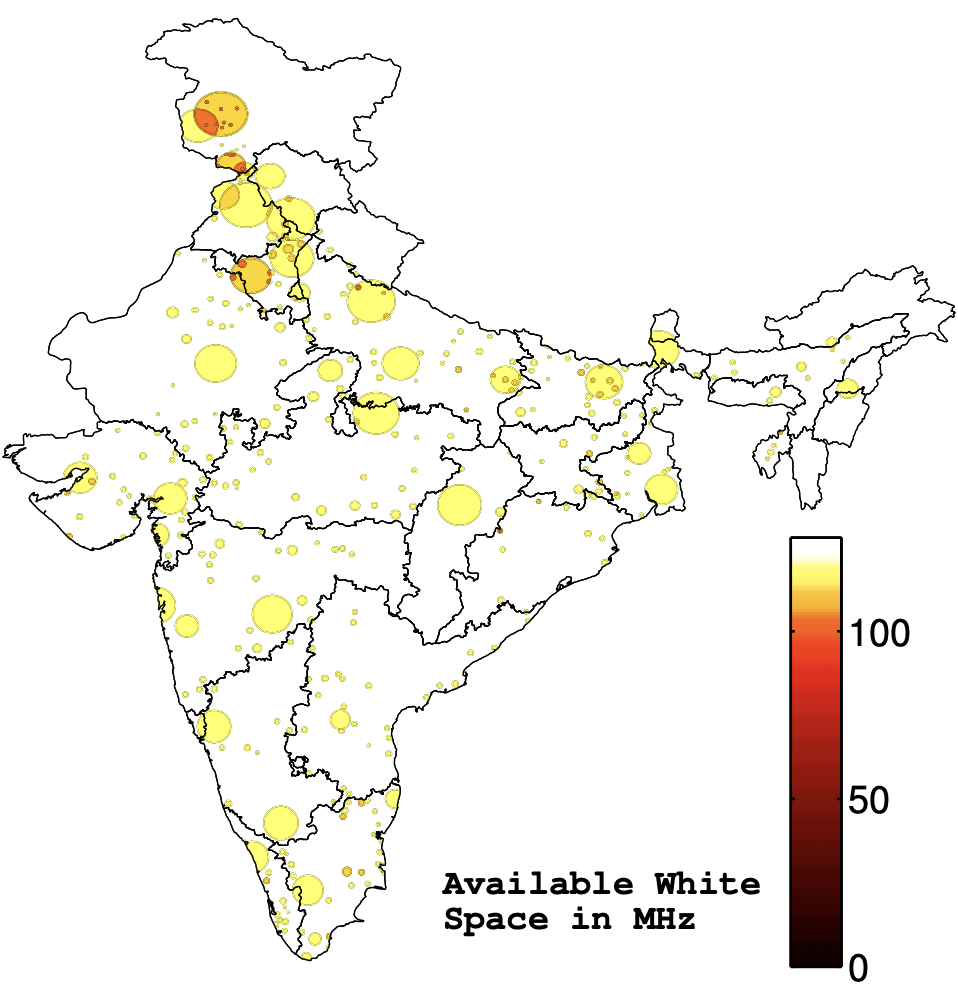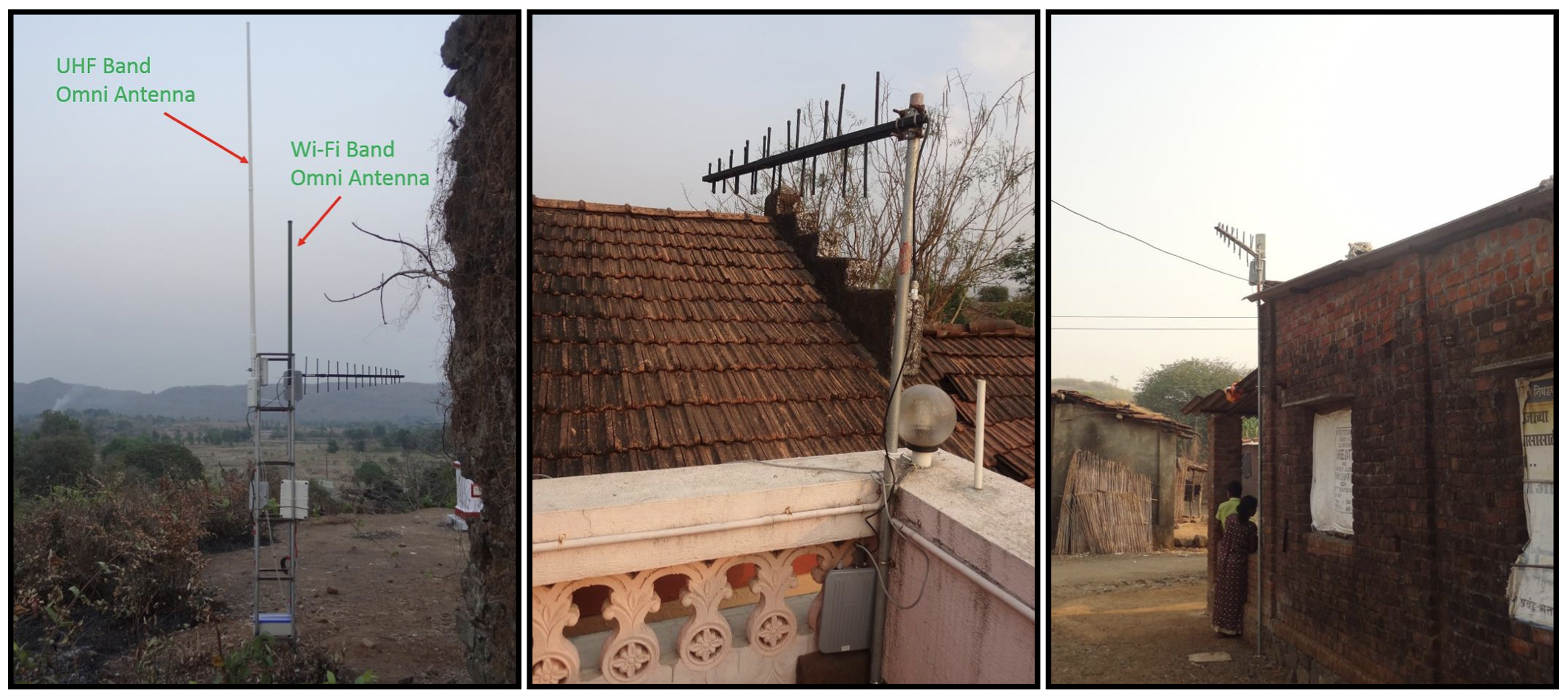Feasibility of TV White Space Operations in India
Background

The Ultra High Frequency (UHF) TV band is extremely lucrative in delivering services over long distances. Terrestrial TV transmitters operating in this band typically re-use frequencies over large distances, creating geographical regions where certain TV channels may be unused. These "voids" constitute TV White Spaces. In many countries, this band has been explored for delivering Internet services, especially in rural areas, where Internet coverage may be sparse.
In this project, we evaluate the potential of the use of TV White Spaces in India. We first estimated the available TV White Spaces in India. Our study revealed that the vast majority of the UHF TV band is underutilized throughout India. This motivated us to find a viable use of this frequency band.
We proposed to utilize long-range TVWS links in provisioning broadband connectivity to rural areas in India. As a demonstration of this proposal, we set up a test-bed with Wi-Fi-based devices operating in the UHF TV band in six villages in the Palghar district of Maharashtra state.
Our Contributions
- We perform the performance analysis of uplink MU-OFDMA in 802.11ax in the combined random access/scheduled access mode of transmission.
- We propose an algorithm to achieve the optimal balance between random access RUs and scheduled access RUs and validate the algorithm using ns-3 simulations.
- We study the coexistence of Wi-Fi 6 and 5G NR-U in the context of their operations in the 6 GHz Bands. We highlight that the MU OFDMA mode of operation in IEEE 802.11ax not only benefits Wi-Fi 6 networks but also benefits the 5G NR-U network when the two networks coexist.
Test-bed Details
Videos
Topology

Test-bed Images

Media Coverage
- To bring more internet access to India, technologists are using TV spectrum, Business Standard, May 23, 2017.
- Boosting digital footprint in rural areas, The Hindu, August 07, 2015.
- IIT-B works with TV band space to take broadband to rural areas, The Indian Express, July 28, 2015.
Publications
-
Licensed but unutilized television (TV) band spectrum is called as TV white space in the literature. Ultra high frequency (UHF) TV band spectrum has very good wireless radio propagation characteristics. The amount of TV white space in the UHF TV band in India is of interest. Comprehensive quantitative assessment and estimates for the TV white space in the 470-590 MHz band for four zones of India (all except north) are presented in this work. This is the first effort in India to estimate TV white spaces in a comprehensive manner. The average available TV white space per unit area in these four zones is calculated using two methods: (i) the primary (licensed) user and secondary (unlicensed) user point of views; and, (ii) the regulations of Federal Communications Commission in the United States. By both methods, the average available TV white space in the UHF TV band is shown to be more than 100 MHz! A TV transmitter frequency reassignment algorithm is also described. Based on spatial-reuse ideas, a TV channel frequency allocation scheme is presented which results in insignificant interference to the TV receivers while using the smallest bandwidth for existing transmission across the four zones. In the proposed reassignment, it is found that four TV band channels (or 32 MHz) are sufficient to provide the existing UHF TV band coverage in India.
[arXiv | IEEE Xplore | Extended Version] -
TV white space (TVWS) geolocation database is being used for the protection of the terrestrial TV broadcast receivers, and the coexistence of secondary devices. To the best of our knowledge, though TV White Space calculations are available, an active online database does not exist for India. In this paper, the development of the first TVWS database for India is detailed and is released for public access. A standardized protocol to access the TVWS database on a readily available hardware platform is implemented. A hardware prototype, which is capable of querying the TVWS database and operating in the TV band without causing harmful interference to the TV receivers in UHF TV bands, is developed. The source code of our implementation has been released under the GNU general public license version 2.0.
[IEEE Xplore] -
One of the major impediments to providing broadband connectivity in semi-urban and rural India is the lack of robust and affordable backhaul. Fiber connectivity in terms of backhaul that is being planned (or provided) by the Government of India would reach only till rural offices (named Gram Panchayat) in the Indian rural areas. In this exposition, we articulate how TV white space can address the challenge in providing broadband connectivity to a billion plus population within India. The villages can form local Wi-Fi clusters. The problem of connecting the Wi-Fi clusters to the optical fiber points can be addressed using a TV white space based backhaul (middle-mile) network.
The amount of TV white space present in India is very large when compared with the developed world. Therefore, we discuss a backhaul architecture for rural India, which utilizes TV white spaces. We also showcase results from our TV white space testbed, which support the effectiveness of backhaul by using TV white spaces. Our testbed provides a broadband access network to rural population in thirteen villages.The testbed is deployed over an area of 25km2 , and extends seamless broadband connectivity from optical fiber locations or Internet gateways to remote (difficult to connect) rural regions. We also discuss standards and TV white space regulations, which are pertinent to the backhaul architecture mentioned above.
[arXiv | IEEE Xplore]